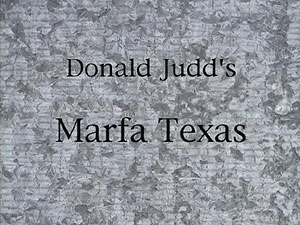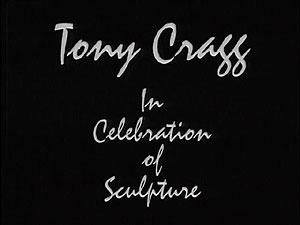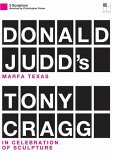| Reviews & Columns |
|
Reviews DVD TV on DVD Blu-ray 4K UHD International DVDs In Theaters Reviews by Studio Video Games Features Collector Series DVDs Easter Egg Database Interviews DVD Talk Radio Feature Articles Columns Anime Talk DVD Savant Horror DVDs The M.O.D. Squad Art House HD Talk Silent DVD
|
DVD Talk Forum |
|
|
| Resources |
|
DVD Price Search Customer Service #'s RCE Info Links |
|
Columns
|
|
|
Two Sculptors: Donald Judd's Marfa Texas and Tony Gragg
 In 10 Words or Less
In 10 Words or LessTwo guys who are good with their hands
Reviewer's Bias*
Loves: Good documentaries, art
Likes: Sculpture
Dislikes: Pretentiousness
Hates: Dull presentation, bare-bones DVD
The Movies
Donald Judd's Marfa, Texas
One of America's finest minimalist artists, at least in my opinion, Donald Judd is a unique choice to profile in a documentary. A soft-spoken man whose artwork speaks for itself with simplicity and quiet strength, he is hardly the type of bombastic personality one thinks of when the term "New York Artist" is discussed. He actually comes across as a very down-to-earth man with definite concepts about art and how it should be viewed.
Because of those views, the late Judd put as much importance on the display as the art itself, with two permanent collections, one in New York and one in Marfa, Texas. This movie, directed by noted documentarian Chris Felver, is composed of an interview with Judd and commentary by art critic John Yau to put a spotlight on Judd's three-dimensional art and the unusualjuxtaposition with its sleepy southern hometown. Judd was given plenty of screentime to expand on his thoughts about art and as he and Yau speak, his art is shown in lingering shots and sweeping pans, showing a good variety of works as well as some his most famous creations.
At just 25 minutes in length, the film flies by, and avoids, barely, crossing over into boring educational film status. One must have an appreciation for Judd's work to enjoy the movie though, as the visuals aren't exactly inventive, and the presentation is very dry. That the interview with Judd is the last he ever gave, lends the film a poignancy it might otherwise not deserve, as I've seen more interesting films.
 In Celebration of Sculpture
In Celebration of Sculpture
Older and longer than Marfa, this film is certainly more involved and informative, but it's hard to say that the additional 35 minutes make it any more interesting or entertaining. Watching as sculptor Tony Cragg works on a variety of projects and listening to him talk about his work opens a window on contemporary art that will either enlighten or annoy, depending on one's view of modern art. As he scribbles on a table, stroking loops and lines, it's easy to see it both as an impressive use of mixed media and a bunch of random marks that have no meaning. If illustrating such a duality was the intent of the filmmaker, it wasn't made clear enough.
As someone who prefers the traditional arts, like painting and sketching, seeing Cragg go to town on a log with a power sander doesn't scream art to me. Neither does watching him supervise a team of sculptors drilling and shaping a project, instead of using his own hands. Whereas Judd's work was often cold and angular, Cragg's work is much more organic, but seemingly less personal, as he doesn't "create" it himself. That is, with the exception of the etchings he does, which are direct and emotional, and shown as such as he works on them with less technical tools. This is the type of work that's impressive, not the ones "created" as he plays foosball.
The film spends a great deal of time depicting Cragg's work, with plenty of 360-degree rotations of fish-eye lenses and music that brands the film as something straight out of the '80s. The rest of the film is fly-on-the-wall voyeurism set in the studio, with Cragg free to share his thoughts about art and his work in particularly. Many times, he comes off as a bit full of himself, such as when he decries the use of the word "stuff" when describing materials used in art. But for the most part, he is what you would expect of an artist: introspective. Watching him work and listening to his thoughts wasn't enough to maintain my interest though. It's surprising that two films about artists would have such a lack of style.
 The DVD
The DVD
Delivered on one DVD, these two films are packaged in a clear keepcase with a two-sided cover that has a nice piece of art on the inside. The disc has a static full-frame main menu that echoes the cover art, offering a choice of films and options to watch trailers and check out weblinks. There are no audio options, no subtitles and no closed captioning, as well as no scene selections. This is about as bare bones as it gets.
The Quality
Neither film is going to win any awards for video quality, as both have the full-frame look of older video, with the softness and noise that's a trademark of such media. Colors aren't exactly vivid, and the level of detail is acceptable though some obvious pixelation and haloing can be seen. Picture any documentary you've seen on VHS, and clean it up a bit, and you get the picture.
The audio, presented in a pair of Dolby Digital 2.0 tracks, is clear, though the recording leaves something to be desired, as it has a very home-video feel to it, with echos and an annoying sense of distance. The score that's mixed in, which is clear and strong, makes the natural sound seem even worse.
The Extras
The only included extras are a reel of trailers for other artist films, and a pair of Weblinks. Once again, this is simply a bare bones presentation.
 The Bottom Line
The Bottom Line
Only those with a very healthy interest in the world of art will have any interest in these films, which are perhaps a step above the dull educational documentaries that have been shown in classrooms for decades. Most everyone else will start to get antsy a few minutes in. The DVD doesn't do much to support or supplement the films, with extremely limited options and no real extras, making it harder to recommend to readers. As straight-forward profiles, they are solid, but there's not much to them outside of some slightly interesting insight, a good deal of pretentiousness, and some quality sculptures.
Francis Rizzo III is a native Long Islander, where he works in academia. In his spare time, he enjoys watching hockey, writing and spending time with his wife, daughter and puppy.Follow him on Twitter
*The Reviewer's Bias section is an attempt to help readers use the review to its best effect. By knowing where the reviewer's biases lie on the film's subject matter, one can read the review with the right mindset.
|
| Popular Reviews |
| Sponsored Links |
|
|
| Sponsored Links |
|
|
| Release List | Reviews | Shop | Newsletter | Forum | DVD Giveaways | Blu-Ray | Advertise |
|
Copyright 2024 DVDTalk.com All Rights Reserved. Legal Info, Privacy Policy, Terms of Use,
Manage Preferences,
Your Privacy Choices | |||||||














